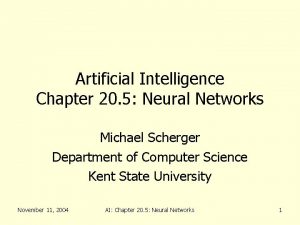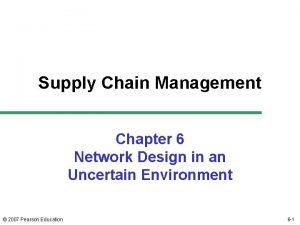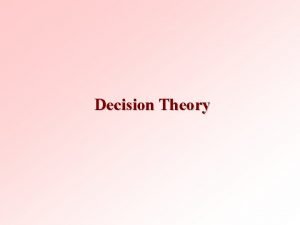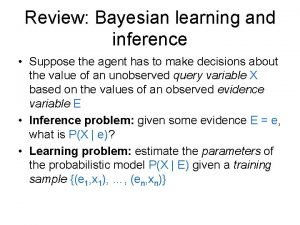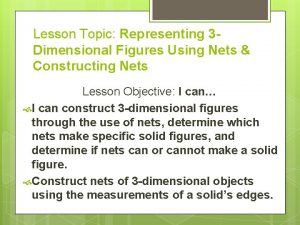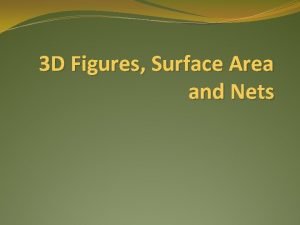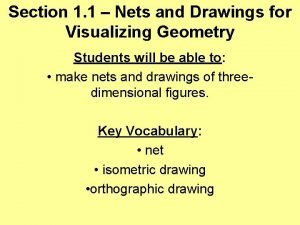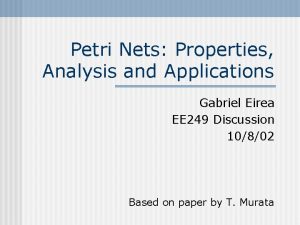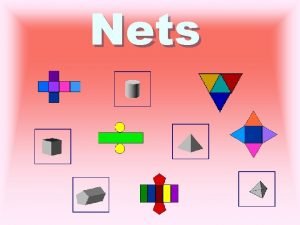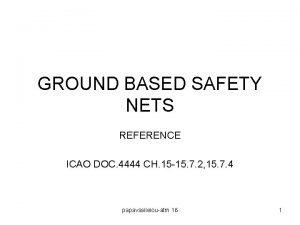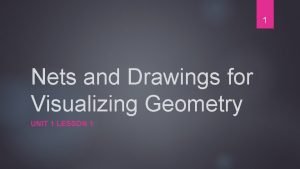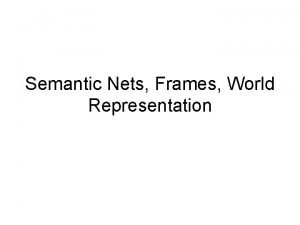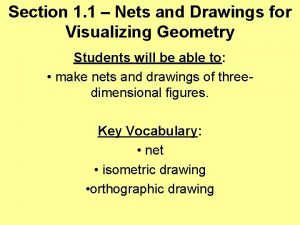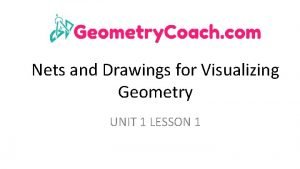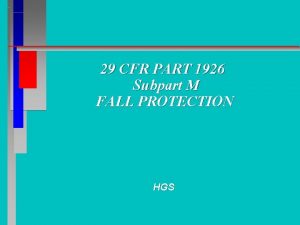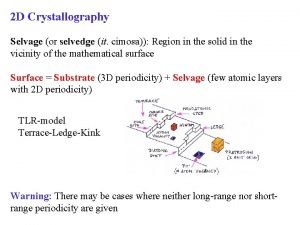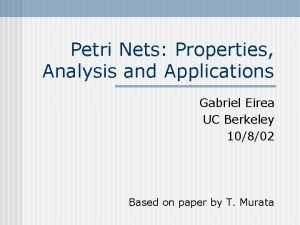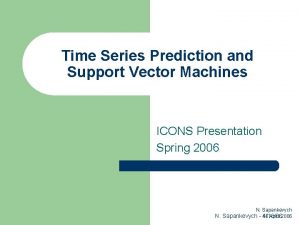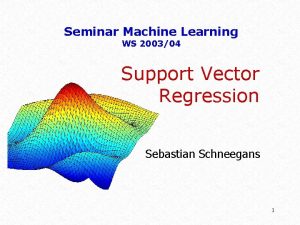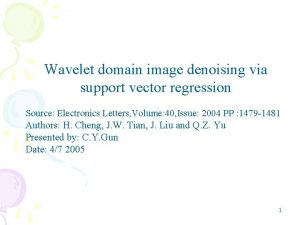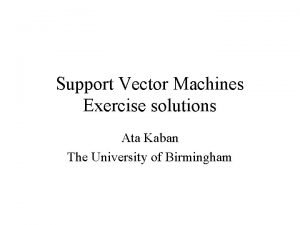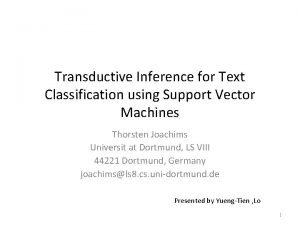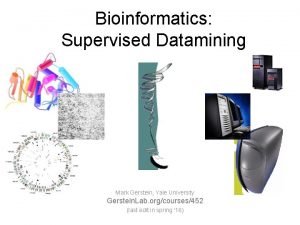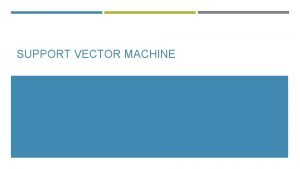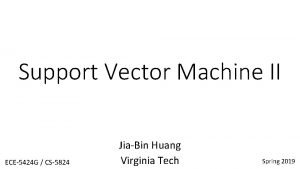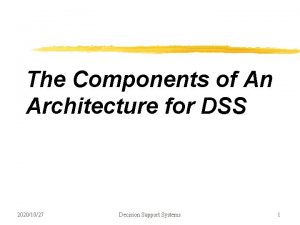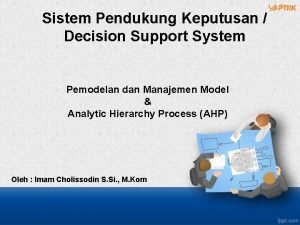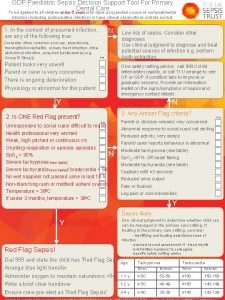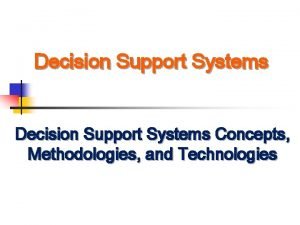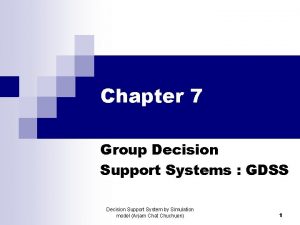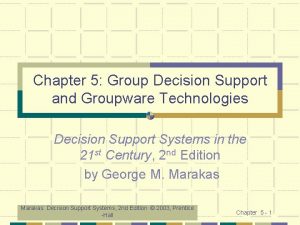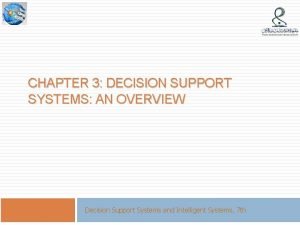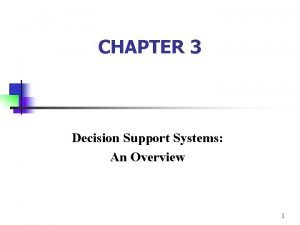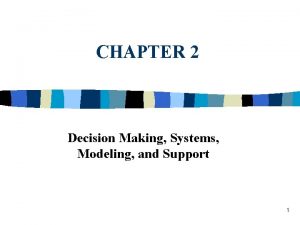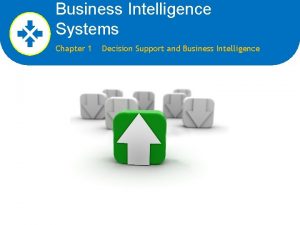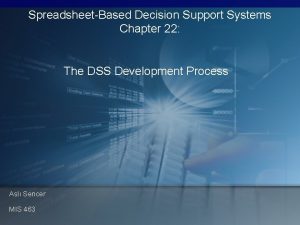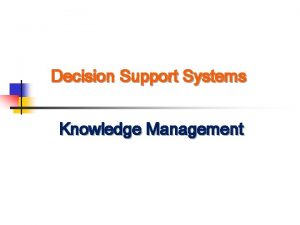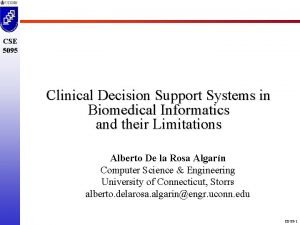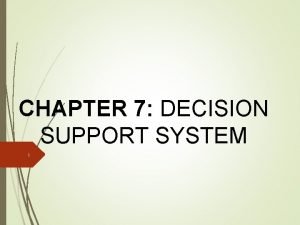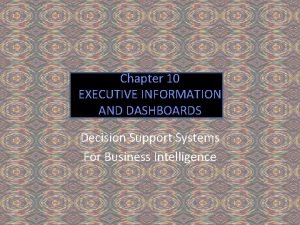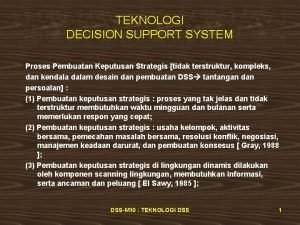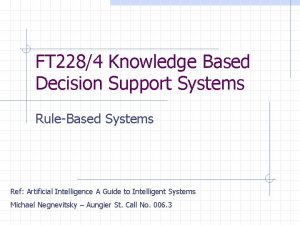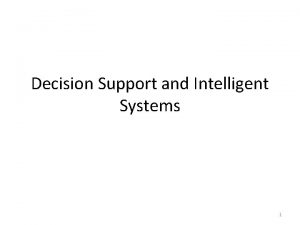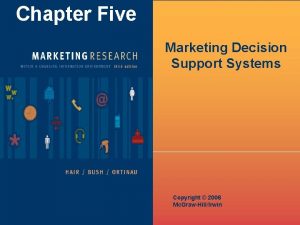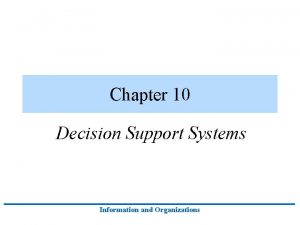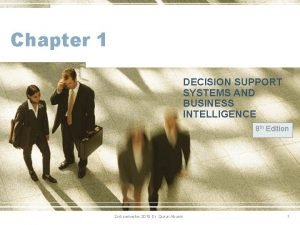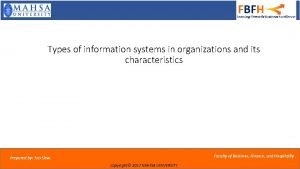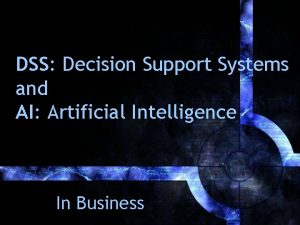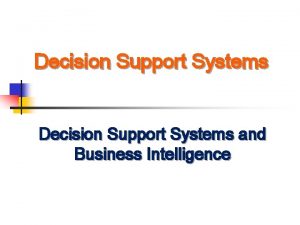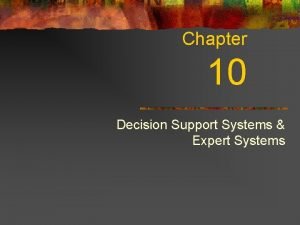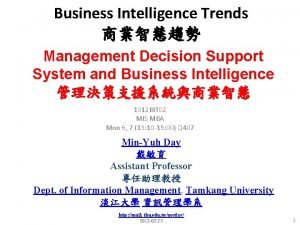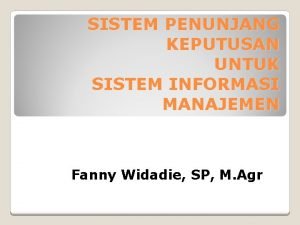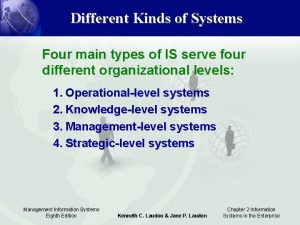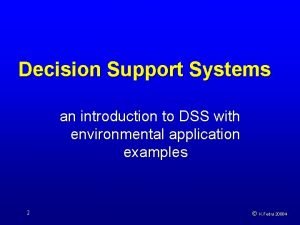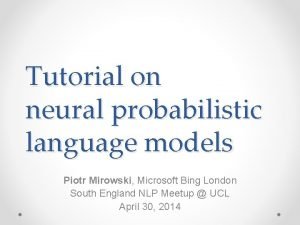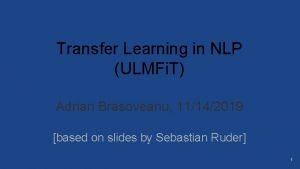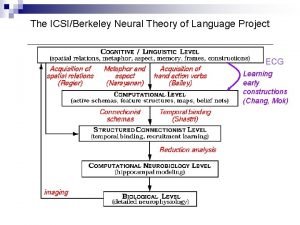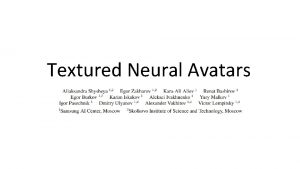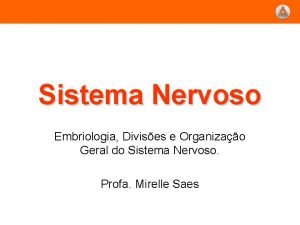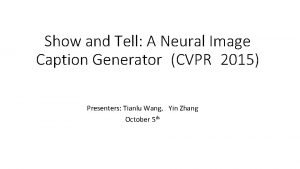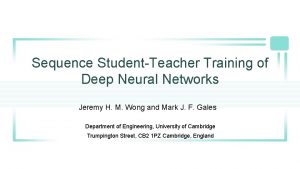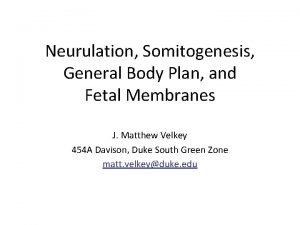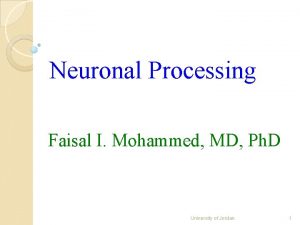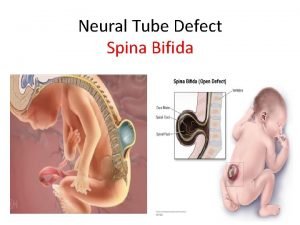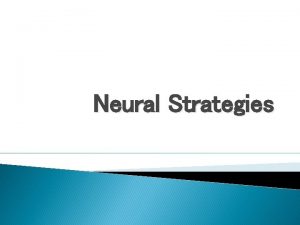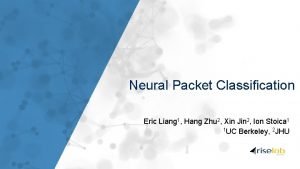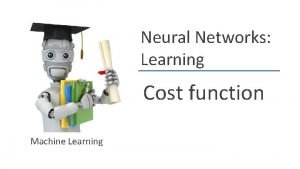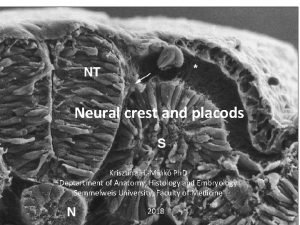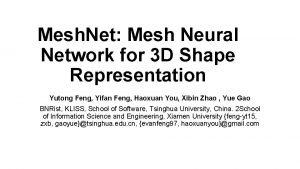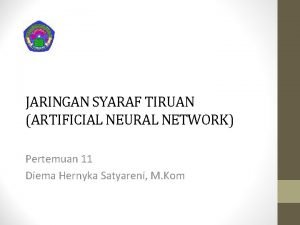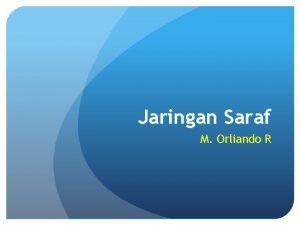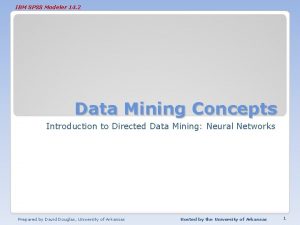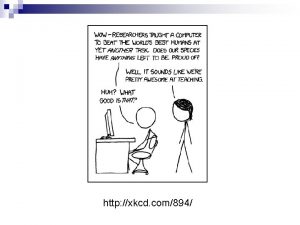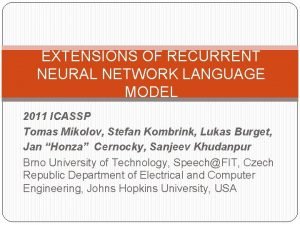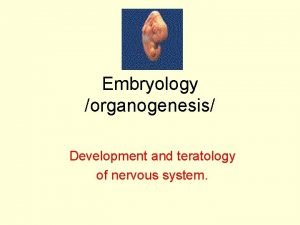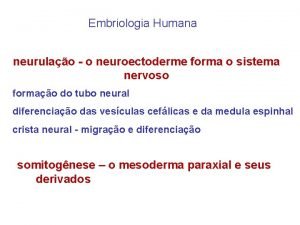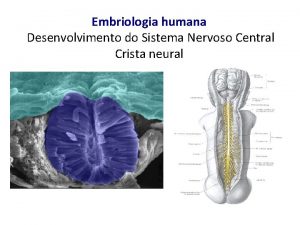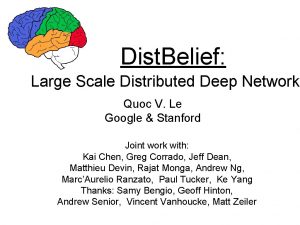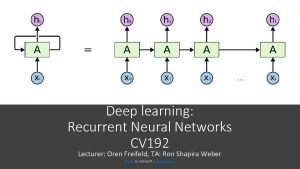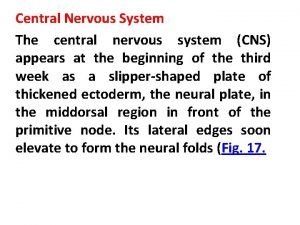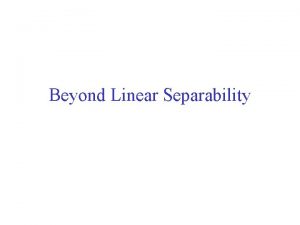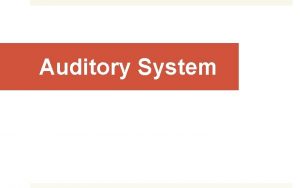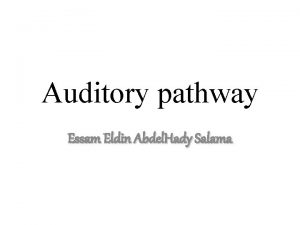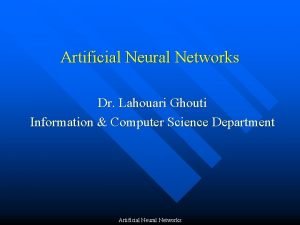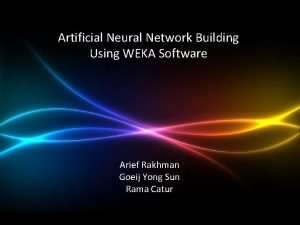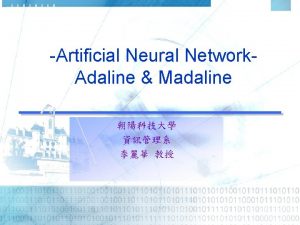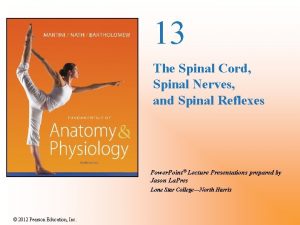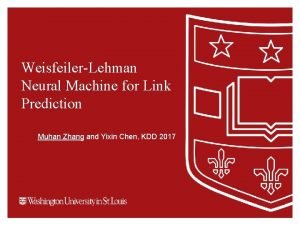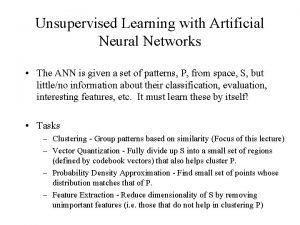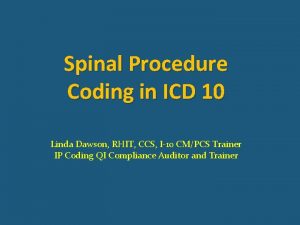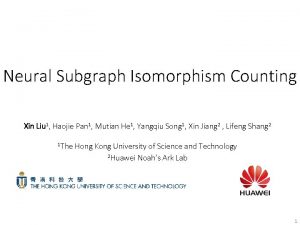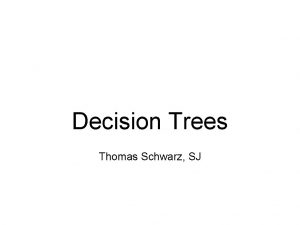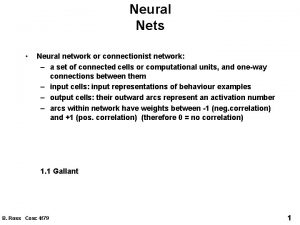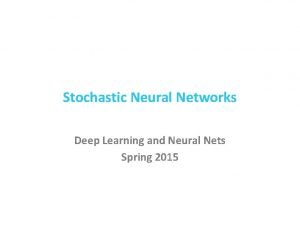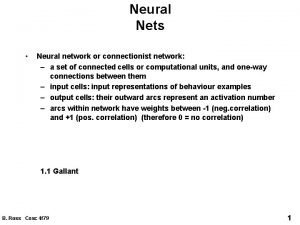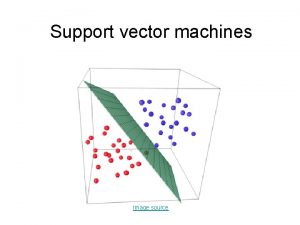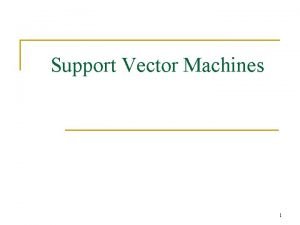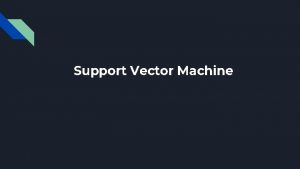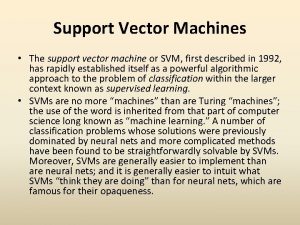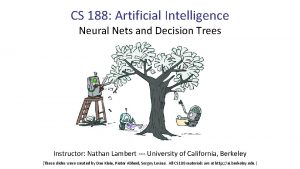l 1106 Neural Nets Decision Trees Support Vector

























![Example Applications l NETtalk [Sejnowski] ¨ Inputs: English text ¨ Output: Spoken phonemes l Example Applications l NETtalk [Sejnowski] ¨ Inputs: English text ¨ Output: Spoken phonemes l](https://slidetodoc.com/presentation_image_h/935879dad944b9c2d1eb5d065899d420/image-26.jpg)

















































![Example : Play Tennis (2) l Attribute Wind ¨ D = [9+, 5 -] Example : Play Tennis (2) l Attribute Wind ¨ D = [9+, 5 -]](https://slidetodoc.com/presentation_image_h/935879dad944b9c2d1eb5d065899d420/image-76.jpg)
![Example : Play Tennis (3) l Attribute Humidity ¨ Dhigh = [3+, 4 -] Example : Play Tennis (3) l Attribute Humidity ¨ Dhigh = [3+, 4 -]](https://slidetodoc.com/presentation_image_h/935879dad944b9c2d1eb5d065899d420/image-77.jpg)


![Example : Play Tennis (6) l Attribute Wind ¨ Dweak = [1+, 2 -] Example : Play Tennis (6) l Attribute Wind ¨ Dweak = [1+, 2 -]](https://slidetodoc.com/presentation_image_h/935879dad944b9c2d1eb5d065899d420/image-80.jpg)
![Example : Play Tennis (7) l Attribute Humidity ¨ Dhigh = [0+, 3 -] Example : Play Tennis (7) l Attribute Humidity ¨ Dhigh = [0+, 3 -]](https://slidetodoc.com/presentation_image_h/935879dad944b9c2d1eb5d065899d420/image-81.jpg)


![Example : Play Tennis (10) l Attribute Wind ¨ Dweak = [3+, 0 -] Example : Play Tennis (10) l Attribute Wind ¨ Dweak = [3+, 0 -]](https://slidetodoc.com/presentation_image_h/935879dad944b9c2d1eb5d065899d420/image-84.jpg)
![Example : Play Tennis (11) l Attribute Humidity ¨ Dhigh = [1+, 1 -] Example : Play Tennis (11) l Attribute Humidity ¨ Dhigh = [1+, 1 -]](https://slidetodoc.com/presentation_image_h/935879dad944b9c2d1eb5d065899d420/image-85.jpg)























































- Slides: 140


강의 개요 l 1일차(10/6): 감독학습 ¨ Neural Nets ¨ Decision Trees ¨ Support Vector Machines l 2일차(10/7): 무감독 학습 ¨ ¨ l Self-Organizing Maps Clustering Algorithms Reinforcement Learning Evolutionary Learning 3일차(10/8): 확률그래프모델 ¨ Bayesian Networks ¨ Markov Random Fields ¨ Particle Filters 2 (c) 2009 -2010 SNU Biointelligence Laboratory, http: //bi. snu. ac. kr/


Approaches to Artificial Intelligence Symbolic AI Rule-Based Systems Connectionist AI Neural Networks Evolutionary AI Genetic Algorithms Molecular AI: DNA Computing © 2007, SNU Biointelligence Lab, http: //bi. snu. ac. kr/ 4

Research Areas and Approaches Research Artificial Intelligence Application Paradigm Learning Algorithms Inference Mechanisms Knowledge Representation Intelligent System Architecture Intelligent Agents Information Retrieval Electronic Commerce Data Mining Bioinformatics Natural Language Proc. Expert Systems Rationalism (Logical) Empiricism (Statistical) Connectionism (Neural) Evolutionary (Genetic) Biological (Molecular) © 2007, SNU Biointelligence Lab, http: //bi. snu. ac. kr/ 5

Day 1 1. Concept of Machine Learning

Learning: Definition l Learning is the improvement of performance in some environment through the acquisition of knowledge resulting from experience in that environment. the improvement of behavior on some performance task through acquisition of knowledge based on partial task experience © 2010, SNU Biointelligence Lab, http: //bi. snu. ac. kr/ 7

Neural Network (MLP) Error Backpropagation Output Comparison Information Propagation Weights Input x 1 Input x 2 Output Input x 3 Input Layer Scaling Function Hidden Layer Activation Function Output Layer Activation Function © 2010, SNU Biointelligence Lab, http: //bi. snu. ac. kr/ 8

Application Example: Autonomous Land Vehicle (ALV) NN learns to steer an autonomous vehicle. l 960 input units, 4 hidden units, 30 output units l Driving at speeds up to 70 miles per hour l ALVINN System Image of a forward mounted camera Weight values for one of the hidden units © 2010, SNU Biointelligence Lab, http: //bi. snu. ac. kr/ 9



(참고: Willow Garage) 가정/사무실 도우미 로봇 l PR 2 Robot Cleans Up http: //www. youtube. com/watch? v=g Yqfa-Ytv. W 4&feature=related l PR 2 Robot Plays Pool http: //www. youtube. com/watch? v= mg. HUNfq. Ih. Ac&feature=related PR 2 Robot of Willow Garage 12 © 2010, SNU Biointelligence Lab, http: //bi. snu. ac. kr/




Machine Learning: Three Tasks l Supervised Learning l Unsupervised Learning l Reinforcement Learning ¨ Estimate an unknown mapping from known input and target output pairs ¨ Learn fw from training set D={(x, y)} s. t. ¨ Classification: y is discrete ¨ Regression: y is continuous ¨ ¨ Only input values are provided Learn fw from D={(x)} s. t. Compression Clustering ¨ ¨ Not target, but rewards (critiques) are provided Learn a heuristic function hw from D={(x, a, c)} s. t. Action selection Policy learning © 2007, SNU Biointelligence Lab, http: //bi. snu. ac. kr/ 16



기계학습 기술: 대표적인 알고리즘 l Symbolic Learning l ¨ Bayesian Networks ¨ Helmholtz Machines ¨ Version Space Learning ¨ Case-Based Learning l l ¨ Markov Random Fields ¨ Hypernetworks Neural Learning ¨ ¨ Multilayer Perceptrons Self-Organizing Maps Support Vector Machines Kernel Machines Evolutionary Learning ¨ ¨ ¨ Evolution Strategies Evolutionary Programming Genetic Algorithms Genetic Programming Molecular Programming Probabilistic Learning ¨ Latent Variable Models ¨ Generative Topographic Mapping l Other Methods ¨ ¨ ¨ Decision Trees Reinforcement Learning Boosting Algorithms Mixture of Experts Independent Component Analysis © 2007, SNU Biointelligence Lab, http: //bi. snu. ac. kr/ 19


Day 1 2. Neural Network Learning

From Biological Neuron to Artificial Neuron Dendrite Cell Body Axon

From Biology to Artificial Neural Nets

Properties of Artificial Neural Networks l A network of artificial neurons l Characteristics t t t <Multilayer Perceptron Network> Nonlinear I/O mapping Adaptivity Generalization ability Fault-tolerance (graceful degradation) Biological analogy

Problems Appropriate for Neural Networks l Many training examples available l Outputs can be discrete or continuous-valued or their vectors. l May contain noise in training examples l Tolerant to long training time l Fast execution time l Not necessary to explain the prediction results
![Example Applications l NETtalk Sejnowski Inputs English text Output Spoken phonemes l Example Applications l NETtalk [Sejnowski] ¨ Inputs: English text ¨ Output: Spoken phonemes l](https://slidetodoc.com/presentation_image_h/935879dad944b9c2d1eb5d065899d420/image-26.jpg)
Example Applications l NETtalk [Sejnowski] ¨ Inputs: English text ¨ Output: Spoken phonemes l Phoneme recognition [Waibel] ¨ Inputs: wave form features ¨ Outputs: b, c, d, … l Robot control [Pomerleau] ¨ Inputs: perceived features ¨ Outputs: steering control

Application: Autonomous Land Vehicle (ALV) NN learns to steer an autonomous vehicle. l 960 input units, 4 hidden units, 30 output units l Driving at speeds up to 70 miles per hour l ALVINN System Image of a forward mounted camera Weight values for one of the hidden units

Application: Data Recorrection by a Hopfield Network original target data Recorrected data after 10 iterations corrupted input data Recorrected data after 20 iterations Fully recorrected data after 35 iterations

Perceptron and Gradient Descent Algorithm

(Simple) Perceptron: A neural net with a single neuron l Perceptron = a linear threshold unit (LTU) ¨ Note: Linear perceptron = linear unit (see below) Input: a vector of real values l Output: 1 or -1 (binary) l Activation function: threshold function l

Linearly Separable vs. Linearly Nonseparable (a) Decision surface for a linearly separable set of examples (correctly classified by a straight line) (b) A set of training examples that is not linearly separable.

Perceptron Training Rule Note: output value o is +1 or -1 (not a real) l Perceptron rule: a learning rule for a threshold unit. l Conditions for convergence l ¨ Training examples are linearly separable. ¨ Learning rate is sufficiently small.

Delta Rule: Least Mean Square (LMS) Error Linear unit (linear perceptron) l Note: output value o is a real value (not binary) l Delta rule: learning rule for an unthresholded perceptron (i. e. linear unit). l ¨ Delta rule is a gradient-descent rule.

Gradient Descent Method

Delta Rule for Error Minimization

Perceptron Learning Algorithm

Multilayer Perceptron

Multilayer Perceptrons x 1 y 1 … x 2 … … ym xn Input layer Hidden layer Output layer • x: input vector • y: output vector • Supervised learning • Gradient search • Noise immunity • Learning algorithm: Backpropagation © 2007, SNU Biointelligence Lab, http: //bi. snu. ac. kr/ 38

Multilayer Networks and its Decision Boundaries * * Decision regions of a multilayer feedforward network. The network was trained to recognize 1 of 10 vowel sounds occurring in the context “h_d” The network input consists of two parameter, F 1 and F 2, obtained from a spectral analysis of the sound. The 10 network outputs correspond to the 10 possible vowel sounds.

Differentiable Threshold Unit l Sigmoid function: nonlinear, differentiable

Error Function for BP l l E defined as a sum of the squared errors over all the output units k for all the training examples d. Error surface can have multiple local minima ¨ Guarantee toward some local minimum ¨ No guarantee to the global minimum

Backpropagation Learning Algorithm for MLP

Adding Momentum l Original weight update rule for BP: l Adding momentum ¨ Help to escape a small local minima in the error surface. ¨ Speed up the convergence.

Derivation of the BP Rule l Notations ¨ xij : the ith input to unit j ¨ wij : the weight associated with the ith input to unit j ¨ netj : the weighted sum of inputs for unit j ¨ oj : the output computed by unit j ¨ tj : the target output for unit j ¨ : the sigmoid function ¨ outputs : the set of units in the final layer of the network ¨ Downstream(j) : the set of units whose immediate inputs include the output of unit j

Derivation of the BP Rule l Error measure: l Gradient descent: l Chain rule:

Case 1: Rule for Output Unit Weights l Step 1: l Step 2: l Step 3: l All together:

Case 2: Rule for Hidden Unit Weights l Step 1: l Thus:

BP for MLP: revisited

Hidden Layer Representations BP has an ability to discover useful intermediate representations at the hidden unit layers inside the networks which capture properties of the input spaces that are most relevant to learning the target function. l When more layers of units are used in the network, more complex features can be invented. l But the representations of the hidden layers are very hard to understand for humans. l

Hidden Layer Representation for Identity Function

Hidden Layer Representation for Identity Function * The evolving sum of squared errors for each of the eight output units as the number of training iterations (epochs) increase

Hidden Layer Representation for Identity Function * The evolving hidden layer representation for the input string “ 01000000”

Hidden Layer Representation for Identity Function * The evolving weights for one of the three hidden units

Generalization and Overfitting l Continuing training until the training error falls below some predetermined threshold is a poor strategy since BP is susceptible to overfitting. ¨ Need to measure the generalization accuracy over a validation set (distinct from the training set). l Two different types of overffiting ¨ Generalization error first decreases, then increases, even the training error continues to decrease. ¨ Generalization error decreases, then increases, then decreases again, while the training error continues to decreases.

Two Kinds of Overfitting Phenomena

Techniques for Overcoming the Overfitting Problem l Weight decay ¨ Decrease each weight by some small factor during each iteration. ¨ This is equivalent to modifying the definition of E to include a penalty term corresponding to the total magnitude of the network weights. ¨ The motivation for the approach is to keep weight values small, to bias learning against complex decision surfaces l k-fold cross-validation ¨ Cross validation is performed k different times, each time using a different partitioning of the data into training and validation sets ¨ The result are averaged after k times cross validation.

Designing an Artificial Neural Network for Face Recognition Application

ANN for Face Recognition 960 x 3 x 4 network is trained on gray-level images of faces to predict whether a person is looking to their left, right, ahead, or up.

Problem Definition l Possible learning tasks ¨ Classifying camera images of faces of people in various poses. ¨ Direction, Identity, Gender, . . . l Data: ¨ 624 grayscale images for 20 different people ¨ 32 images person, varying < person’s expression (happy, sad, angry, neutral) < direction (left, right, straight ahead, up) < with and without sunglasses ¨ resolution of images: 120 x 128, each pixel with a grayscale intensity between 0 (black) and 255 (white) l Task: Learning the direction in which the person is facing.

Factors for ANN Design in the Face Recognition Task Input encoding Output encoding Network graph structure Other learning algorithm parameters

Input Coding for Face Recognition l Possible Solutions ¨ Extract key features using preprocessing ¨ Coarse-resolution l Features extraction ¨ edges, regions of uniform intensity, other local image features ¨ Defect: High preprocessing cost, variable number of features l Coarse-resolution ¨ Encode the image as a fixed set of 30 x 32 pixel intensity values, with one network input per pixel. ¨ The 30 x 32 pixel image is a coarse resolution summary of the original 120 x 128 pixel image ¨ Coarse-resolution reduces the number of inputs and weights to a much more manageable size, thereby reducing computational demands.

Output Coding for Face Recognition l Possible coding schemes ¨ Using one output unit with multiple threshold values ¨ Using multiple output units with single threshold value. l One unit scheme ¨ Assign 0. 2, 0. 4, 0. 6, 0. 8 to encode four-way classification. l Multiple units scheme (1 -of-n output encoding) ¨ Use four distinct output units ¨ Each unit represents one of the four possible face directions, with highest-valued output taken as the network prediction

Output Coding for Face Recognition l Advantages of 1 -of-n output encoding scheme ¨ It provides more degrees of freedom to the network for representing the target function. ¨ The difference between the highest-valued output and the second-highest can be used as a measure of the confidence in the network prediction. l Target value for the output units in 1 -of-n encoding scheme ¨ < 1, 0, 0, 0 > v. s. < 0. 9, 0. 1, 0. 1 > ¨ < 1, 0, 0, 0 >: will force the weights to grow without bound. ¨ < 0. 9, 0. 1, 0. 1 >: the network will have finite weights.

Network Structure for Face Recognition One hidden layer v. s. more hidden layers l How many hidden nodes is used? l ¨ Using 3 hidden units: < test accuracy for the face data = 90% < Training time = 5 min on Sun Sprac 5 ¨ Using 30 hidden units: < test accuracy for the face data = 91. 5% < Training time = 1 hour on Sun Sparc 5

Other Parameters for Face Recognition Learning rate = 0. 3 l Momentum = 0. 3 l Weight initialization: small random values near 0 l Number of iterations: Cross validation l ¨ After every 50 iterations, the performance of the network was evaluated over the validation set. ¨ The final selected network is the one with the highest accuracy over the validation set

Day 1 3. Decision Tree Learning

Decision Trees Nodes: attributes l Edges: values l Terminal nodes: class labels l quicktime no yes YES unix yes no computer no yes NO space ` NO no clinton no NO l yes Learning Algorithm: C 4. 5 YES yes YES © 2007, SNU Biointelligence Lab, http: //bi. snu. ac. kr/ 67

Main Idea Classification by Partitioning Example Space l Goal : Approximating discrete-valued target functions l Appropriate Problems l ¨ ¨ Examples are represented by attribute-value pairs. The target function has discrete output value. Disjunctive description may be required. The training data may contain missing attribute values. SNU Center for Bioinformation Technology (CBIT) 68

q Example Problem (Play Tennis) Day Outlook Temperature Humidity Wind Play. Tennis D 1 D 2 D 3 D 4 D 5 D 6 D 7 D 8 D 9 D 10 D 11 D 12 D 13 D 14 Sunny Overcast Rain Overcast Sunny Rain Sunny Overcast Rain Hot Hot Mild Cool Mild Hot Mild High Normal Normal High Weak Strong Weak Weak Strong Weak Strong No No Yes Yes Yes No

Example Space No Yes (Outlook = Sunny & Humidity = High) (Outlook = Sunny & Humidity = Normal) Yes (Outlook = Overcast) Yes No (Outlook = Rain & Wind = Weak) (Outlook = Rain & Wind = Strong) SNU Center for Bioinformation Technology (CBIT) 70

Decision Tree Representation Outlook Sunny Humidity High NO Overcast Rain Wind YES Normal YES NO SNU Center for Bioinformation Technology (CBIT) YES 71

Basic Decision Tree Learning l Which Attribute is Best? ¨ Select the attribute that is most useful for classifying examples. ¨ Quantitative Measure Information Gain < For Attribute A, relative to a collection of data D < < Expected Reduction of Entropy SNU Center for Bioinformation Technology (CBIT) 72

Entropy Impurity of an Arbitrary Collection of Examples l Minimum number of bits of information needed to encode the classification of an arbitrary member of D 1. 0 Entropy(S) l 0. 0 SNU Center for Bioinformation Technology (CBIT) 1. 0 73

Constructing Decision Tree SNU Center for Bioinformation Technology (CBIT) 74

Example : Play Tennis (1) l Entropy of D SNU Center for Bioinformation Technology (CBIT) 75
![Example Play Tennis 2 l Attribute Wind D 9 5 Example : Play Tennis (2) l Attribute Wind ¨ D = [9+, 5 -]](https://slidetodoc.com/presentation_image_h/935879dad944b9c2d1eb5d065899d420/image-76.jpg)
Example : Play Tennis (2) l Attribute Wind ¨ D = [9+, 5 -] ¨ Dweak = [6+, 2 -] ¨ Dstrong=[3+, 3 -] [9+, 5 -] : E = 0. 940 Wind Weak [6+, 2 -] : E = 0. 811 SNU Center for Bioinformation Technology (CBIT) Strong [3+, 3 -] : E = 1. 0 76
![Example Play Tennis 3 l Attribute Humidity Dhigh 3 4 Example : Play Tennis (3) l Attribute Humidity ¨ Dhigh = [3+, 4 -]](https://slidetodoc.com/presentation_image_h/935879dad944b9c2d1eb5d065899d420/image-77.jpg)
Example : Play Tennis (3) l Attribute Humidity ¨ Dhigh = [3+, 4 -] ¨ Dnormal=[6+, 1 -] [9+, 5 -] : E = 0. 940 Humidity High [3+, 4 -] : E = 0. 985 SNU Center for Bioinformation Technology (CBIT) Normal [6+, 1 -] : E = 0. 592 77

Example : Play Tennis (4) l Best Attribute? ¨ Gain(D, Outlook) = 0. 246 ¨ Gain(D, Humidity) = 0. 151 ¨ Gain(D, Wind) = 0. 048 ¨ Gain(D, Temperature) = 0. 029 [9+, 5 -] : E = 0. 940 Outlook Sunny Overcast [2+, 3 -] : (D 1, D 2, D 8, D 9, D 11) [4+, 0 -] : (D 3, D 7, D 12, D 13) YES Rain [3+, 2 -] : (D 4, D 5, D 6, D 10, D 14) SNU Center for Bioinformation Technology (CBIT) 78

Example : Play Tennis (5) l Entropy Dsunny Day Outlook Temperature Humidity Wind Play. Tennis D 1 D 2 D 8 D 9 D 11 Sunny Sunny Hot Mild Cool Mild High Normal Weak Strong No No No Yes SNU Center for Bioinformation Technology (CBIT) 79
![Example Play Tennis 6 l Attribute Wind Dweak 1 2 Example : Play Tennis (6) l Attribute Wind ¨ Dweak = [1+, 2 -]](https://slidetodoc.com/presentation_image_h/935879dad944b9c2d1eb5d065899d420/image-80.jpg)
Example : Play Tennis (6) l Attribute Wind ¨ Dweak = [1+, 2 -] ¨ Dstrong=[1+, 1 -] [2+, 3 -] : E = 0. 971 Wind Weak [1+, 2 -] : E = 0. 918 SNU Center for Bioinformation Technology (CBIT) Strong [1+, 1 -] : E = 1. 0 80
![Example Play Tennis 7 l Attribute Humidity Dhigh 0 3 Example : Play Tennis (7) l Attribute Humidity ¨ Dhigh = [0+, 3 -]](https://slidetodoc.com/presentation_image_h/935879dad944b9c2d1eb5d065899d420/image-81.jpg)
Example : Play Tennis (7) l Attribute Humidity ¨ Dhigh = [0+, 3 -] ¨ Dnormal=[2+, 0 -] [2+, 3 -] : E = 0. 971 Humidity High [0+, 3 -] : E = 0. 00 SNU Center for Bioinformation Technology (CBIT) Normal [2+, 0 -] : E = 0. 00 81

Example : Play Tennis (8) Best Attribute? l ¨ Gain(Dsunny, Humidity) = 0. 971 ¨ Gain(Dsunny, Wind) = 0. 020 ¨ Gain(Dsunny, Temperature) = 0. 571 [9+, 5 -] : E = 0. 940 Outlook Sunny Humidity High NO Overcast YES Normal Rain [3+, 2 -] : (D 4, D 5, D 6, D 10, D 14) YES SNU Center for Bioinformation Technology (CBIT) 82

Example : Play Tennis (9) l Entropy Drain Day Outlook Temperature Humidity Wind Play. Tennis D 4 D 5 D 6 D 10 D 14 Rain Rain Mild Cool Mild High Normal High Weak Strong Yes No SNU Center for Bioinformation Technology (CBIT) 83
![Example Play Tennis 10 l Attribute Wind Dweak 3 0 Example : Play Tennis (10) l Attribute Wind ¨ Dweak = [3+, 0 -]](https://slidetodoc.com/presentation_image_h/935879dad944b9c2d1eb5d065899d420/image-84.jpg)
Example : Play Tennis (10) l Attribute Wind ¨ Dweak = [3+, 0 -] ¨ Dstrong=[0+, 2 -] [3+, 2 -] : E = 0. 971 Wind Weak [3+, 0 -] : E = 0. 00 SNU Center for Bioinformation Technology (CBIT) Strong [0+, 2 -] : E = 0. 00 84
![Example Play Tennis 11 l Attribute Humidity Dhigh 1 1 Example : Play Tennis (11) l Attribute Humidity ¨ Dhigh = [1+, 1 -]](https://slidetodoc.com/presentation_image_h/935879dad944b9c2d1eb5d065899d420/image-85.jpg)
Example : Play Tennis (11) l Attribute Humidity ¨ Dhigh = [1+, 1 -] ¨ Dnormal=[2+, 1 -] [2+, 3 -] : E = 0. 971 Humidity High [1+, 1 -] : E = 1. 00 SNU Center for Bioinformation Technology (CBIT) Normal [2+, 1 -] : E = 0. 918 85

Example : Play Tennis (12) l Best Attribute? ¨ Gain(Drain, Humidity) = 0. 020 ¨ Gain(Drain, Wind) = 0. 971 ¨ Gain(Drain, Temperature) = 0. 020 Sunn y Humidity High NO Outlook Overcas t YES Rain Wind Normal YES SNU Center for Bioinformation Technology (CBIT) NO YES 86

Avoiding Overfitting Data l Definition ¨ Given a hypothesis space H, a hypothesis h H is said to overfit the data if there exists some alternative hypothesis h’ H, such that h has smaller error than h’ over the training examples, but h’ has a smaller error than h over entire distribution of instances. l Occam’s Razor ¨ Prefer the simplest hypothesis that fits the data. SNU Center for Bioinformation Technology (CBIT) 87

Avoiding Overfitting Data SNU Center for Bioinformation Technology (CBIT) 88

Solutions to Overfitting 1. Partition examples into training, test, and validation set. 2. Use all data for training, but apply a statistical test to estimate whether expanding (or pruning) a particular node is likely to produce an improvement beyond the training set. 3. Use an explicit measure of the complexity for encoding the training examples and the decision tree, halting growth of the tree when this encoding is minimized. SNU Center for Bioinformation Technology (CBIT) 89

Summary Decision trees provide a practical method for concept learning and discrete-valued functions. l ID 3 searches a complete hypothesis space. l Overfitting is an important issue in decision tree learning. l SNU Center for Bioinformation Technology (CBIT) 90

Day 1 4 -5. 실습

Plan for ML Exercise l Day 1: Classification ¨ Program: Weka ¨ Agenda: classification by Neural Network(NN) and Decision Tree (DT) l Day 2: Clustering ¨ Program: Genesis ¨ Agenda: k-means /hierarchical clustering, SOM l Day 3: Bayesian Network ¨ Program: Ge. NIe ¨ Agenda: designing / learning / inference in Bayesian networks (C) 2010, SNU Biointelligence Lab, http: //bi. snu. ac. kr/

Day 1 Classification – The Tool for Practice l Weka 3: Data Mining Software in Java ¨ Collection of machine learning algorithms for data mining tasks ¨ What you can do with Weka are < data pre-processing, feature selection, classification, regression, clustering, association rules, and visualization ¨ Weka is an open source software issued under the GNU General Public License ¨ How to get? http: //www. cs. waikato. ac. nz/ml/weka/ or just type ‘Weka’ in google. (C) 2010, SNU Biointelligence Lab, http: //bi. snu. ac. kr/

Classification Using Weka - Problems l Pima Indians Diabetes (2 -class problem) ¨ Pima Indians have the highest prevalence of diabetes in the world ¨ We will build classification models that diagnoses if the patient shows signs of diabetes l Handwritten Digit Recognition (10 -class problem) ¨ The MNIST database of handwritten digits contains digits written by office workers and students ¨ We will build a recognition model based on classifiers with the reduced set of MNIST (C) 2010, SNU Biointelligence Lab, http: //bi. snu. ac. kr/

Classification Using Weka - Algorithms Neural Network (Multilayer Perceptron) Decision Tree (C) 2010, SNU Biointelligence Lab, http: //bi. snu. ac. kr/

Classification Using Weka click • load a file that contains the training data by clicking ‘Open file’ button • ‘ARFF’ or ‘CSV’ formats are readible • Click ‘Multilayer. Perceptron’ • Set parameters for MLP • Set parameters for Test • Click ‘Start’ for learning (C) 2010, SNU Biointelligence Lab, http: //bi. snu. ac. kr/ • Click ‘Classify’ tab • Click ‘Choose’ button • Select ‘weka – function - Multilayer. Perceptron

Classification Using Weka Options for testing the trained model Result output: various measures appear (C) 2010, SNU Biointelligence Lab, http: //bi. snu. ac. kr/

Day 1 6. k-Nearest Neighbor

Different Learning Methods l Eager learning ¨ Explicit description of target function on the whole training set l Instance-based learning ¨ Learning = storing all training instances ¨ Classification = assigning a target function to a new instance ¨ Referred to as “lazy” learning l Kinds of instance-based learning ¨ K-nearest neighbor algorithm ¨ Locally weighted regression ¨ Case-based reasoning

Local vs. Distributed Representation Lazy Learning? Eager Learning 100

K-Nearest Neighbor l Features ¨ All instances correspond to points in an n-dimensional Euclidean space ¨ Classification is delayed till a new instance arrives ¨ Classification done by comparing feature vectors of the different points ¨ Target function may be discrete or real-valued

k-Nearest Neighbor Classifier (k. NN) Memory-Based Learning (x, y=? ) Query Pattern (x 1, y 1=1) (x 2, y 2=1) (x 3, y 3=0) (x 4, y 4=0) (x 5, y 5=1) (x 6, y 6=0). . . (x. N, y. N=1) Learning Set D k=5 1 1 0 0 Three 1’s vs. Two 0’s y=1 1 Match Set © 2010, SNU Biointelligence Lab, http: //bi. snu. ac. kr/ 102

k. NN as a Neural Network (xi, yi) xq Input (vector) … Hidden (vector) yq Output (vector) 103

k-Nearest Neighbor (k. NN) l Training • For each training example <x, f(x)>, add the example to the learning set D Classification • Given a query instance xq, denote the k l instances from D that are nearest to xq • Return xq + + + where (a, b)=1 if a=b, and (a, b)=0 otherwise. l Memory-based or case-based learning © 2010, SNU Biointelligence Lab, http: //bi. snu. ac. kr/ 104

Generalizing k. NN l Divide the input space into local regions and learn simple (constant/linear) models in each patch Unsupervised: Competitive, online clustering l Supervised: Radial-basis func, mixture of experts l 105

Radial-Basis Function Network Locally-tuned units Output (scalar) Hidden (scalar) Input (scalar) 106

Training RBF Hybrid learning: ¨ First layer centers and spreads: Unsupervised k-means ¨ Second layer weights: Supervised gradient-descent l Fully supervised l (Broomhead and Lowe, 1988; Moody and Darken, 1989) l 107

Regression 108

Classification 109

Rules and Exceptions 110 Default rule

Rule-Based Knowledge Incorporation of prior knowledge (before training) l Rule extraction (after training) (Tresp et al. , 1997) l Fuzzy membership functions and fuzzy rules l 111

Day 1 7. Support Vector Machines

Support Vector Machines Bias b K(x, x 1) x 1 x 2 K(x, x 2) Input layer y Output neuron … … xn Type of SVM K(x, xm) Inner product kernel K(x, xi) Polynomial learning machine Radial-basis function network Two-layer perceptron Hidden layer of m inner-product kernels © 2010, SNU Biointelligence Lab, http: //bi. snu. ac. kr/ 113

Support Vector Machines The line that maximizes the minimum margin is a good bet. ¨ The model class of “hyper-planes with a margin of m” has a low VC dimension if m is big. l This maximum-margin separator is determined by a subset of the datapoints. ¨ Datapoints in this subset are called “support vectors”. ¨ It will be useful computationally if only a small fraction of the datapoints are support vectors, because we use the support vectors to decide which side of the separator a test case is on. l The support vectors are indicated by the circles around them.

Training a linear SVM l To find the maximum margin separator, we have to solve the following optimization problem: l This is tricky but it’s a convex problem. There is only one optimum and we can find it without fiddling with learning rates or weight decay or early stopping. ¨ Don’t worry about the optimization problem. It has been solved. Its called quadratic programming. ¨ It takes time proportional to N^2 which is really bad for very big datasets < so for big datasets we end up doing approximate optimization!

Testing a linear SVM l The separator is defined as the set of points for which:

Introducing slack variables l Slack variables are constrained to be non-negative. When they are greater than zero they allow us to cheat by putting the plane closer to the datapoint than the margin. So we need to minimize the amount of cheating. This means we have to pick a value for lamba (this sounds familiar!)

A picture of the best plane with a slack variable

How to make a plane curved Fitting hyperplanes as separators is mathematically easy. ¨ The mathematics is linear. l By replacing the raw input variables with a much larger set of features we get a nice property: ¨ A planar separator in the highdimensional space of feature vectors is a curved separator in the low dimensional space of the raw input variables. l A planar separator in a 20 -D feature space projected back to the original 2 -D space

A potential problem and a magic solution l l If we map the input vectors into a very high-dimensional feature space, surely the task of finding the maximum-margin separator becomes computationally intractable? ¨ The mathematics is all linear, which is good, but the vectors have a huge number of components. ¨ So taking the scalar product of two vectors is very expensive. The way to keep things tractable is to use “the kernel trick” l The kernel trick makes your brain hurt when you first learn about it, but its actually very simple.

The kernel trick l For many mappings from a low-D space to a high-D space, there is a simple operation on two vectors in the low-D space that can be used to compute the scalar product of their two images in the high-D space. Letting the kernel do the work doing the scalar product in the obvious way Low-D High-D

Kernel Examples 1. Gaussian kernel 2. Polynomial kernel

The classification rule l The final classification rule is quite simple: The set of support vectors All the cleverness goes into selecting the support vectors that maximize the margin and computing the weight to use on each support vector. l We also need to choose a good kernel function and we may need to choose a lambda for dealing with non-separable cases. l

Some commonly used kernels Polynomial: Gaussian radial basis function Parameters that the user must choose Neural net: For the neural network kernel, there is one “hidden unit” per support vector, so the process of fitting the maximum margin hyperplane decides how many hidden units to use. Also, it may violate Mercer’s condition.

Support Vector Machines are Perceptrons! SVM’s use each training case, x, to define a feature K(x, . ) where K is chosen by the user. ¨ So the user designs the features. l Then they do “feature selection” by picking the support vectors, and they learn how to weight the features by solving a big optimization problem. l So an SVM is just a very clever way to train a standard perceptron. ¨ All of the things that a perceptron cannot do cannot be done by SVM’s (but it’s a long time since 1969 so people have forgotten this). l

Supplement: SVM as a Kernel Machine

Kernel Methods Approach l The kernel methods approach is to stick with linear functions but work in a high dimensional feature space: The expectation is that the feature space has a much higher dimension than the input space. l

Form of the Functions l So kernel methods use linear functions in a feature space: l For regression this could be the function l For classification require thresholding

Controlling generalisation l The critical method of controlling generalisation is to force a large margin on the training data:

Support Vector Machines l SVM optimization Addresses generalization issue but not the computational cost of dealing with large vectors l

Complexity problem l Let’s apply the quadratic example to a 20 x 30 image of 600 pixels – gives approximately 180000 dimensions! l Would be computationally infeasible to work in this space

Dual Representation l Suppose weight vector is a linear combination of the training examples: l can evaluate inner product with new example

Learning the dual variables Since any component orthogonal to the space spanned by the training data has no effect, general result that weight vectors have dual representation: the representer theorem. l Hence, can reformulate algorithms to learn dual variables rather than weight vector directly l

Dual Form of SVM l The dual form of the SVM can also be derived by taking the dual optimisation problem! This gives: l Note that threshold must be determined from border examples

Using Kernels Critical observation is that again only inner products are used l Suppose that we now have a shortcut method of computing: l l Then we do not need to explicitly compute the feature vectors either in training or testing

Kernel example l As an example consider the mapping l Here we have a shortcut:

Efficiency Hence, in the pixel example rather than work with 180000 dimensional vectors, we compute a 600 dimensional inner product and then square the result! l Can even work in infinite dimensional spaces, eg using the Gaussian kernel: l

Constraints on the kernel l There is a restriction on the function: l This restriction for any training set is enough to guarantee function is a kernel

What Have We Achieved? Replaced problem of neural network architecture by kernel definition l ¨ Arguably more natural to define but restriction is a bit unnatural ¨ Not a silver bullet as fit with data is key ¨ Can be applied to non- vectorial (or high dim) data Gained more flexible regularization/ generalization control l Gained convex optimization problem l ¨ i. e. NO local minima! l However, choosing the right kernel remains as a design issue.

 Singularity 1106
Singularity 1106 Objectives of decision making
Objectives of decision making Financial management process
Financial management process Decision boundary of neural network
Decision boundary of neural network Supply chain network design decisions
Supply chain network design decisions Laplace criterion example
Laplace criterion example Decision trees show the logic structure in a
Decision trees show the logic structure in a Bayes nets
Bayes nets Represent solid figures using nets
Represent solid figures using nets Partitioned semantic network in artificial intelligence
Partitioned semantic network in artificial intelligence Surface area using nets
Surface area using nets Nets and drawings for visualizing geometry
Nets and drawings for visualizing geometry Petri nets properties analysis and applications
Petri nets properties analysis and applications Nets of square pyramid
Nets of square pyramid Nets church planting
Nets church planting List the 4 nets for better internet searching
List the 4 nets for better internet searching Icao 4444
Icao 4444 Lesson 1 nets and drawings for visualizing geometry
Lesson 1 nets and drawings for visualizing geometry Semantic nets and frames
Semantic nets and frames Nets and drawings for visualizing geometry
Nets and drawings for visualizing geometry Cylinder net
Cylinder net Nets blox
Nets blox 29 cfr 1926 subpart m
29 cfr 1926 subpart m Bravais nets
Bravais nets Objects of knowledge
Objects of knowledge Apple sweatshops
Apple sweatshops Yuygo
Yuygo Petri y gabriel
Petri y gabriel Directed line segment math definition
Directed line segment math definition Vector
Vector Why is vector resolution the opposite of vector addition
Why is vector resolution the opposite of vector addition Whats a position vector
Whats a position vector Support vector machine icon
Support vector machine icon Support vector machine regression
Support vector machine regression Father of support vector machine
Father of support vector machine Support vector machine exercise solutions
Support vector machine exercise solutions Transductive support vector machines
Transductive support vector machines Support vector machine pdf
Support vector machine pdf Support vector regression
Support vector regression Support vector regression
Support vector regression Svmsong
Svmsong Structured support vector machine
Structured support vector machine Support vector machine intuition
Support vector machine intuition Decision table and decision tree examples
Decision table and decision tree examples 5 types of information system
5 types of information system Components of decision support system
Components of decision support system Contoh decision support system
Contoh decision support system Navify decision support
Navify decision support Decision support systems and intelligent systems
Decision support systems and intelligent systems Gdp sepsis decision support tool
Gdp sepsis decision support tool Components of decision support system
Components of decision support system Gdss
Gdss Mdm support technologies in dss
Mdm support technologies in dss Bi vs dss
Bi vs dss Components of decision support system
Components of decision support system Types of decision support system
Types of decision support system Decision support system vs expert system
Decision support system vs expert system Decision support and business intelligence systems
Decision support and business intelligence systems Developing spreadsheet-based decision support systems
Developing spreadsheet-based decision support systems Model driven decision support system
Model driven decision support system Decision support system in knowledge management
Decision support system in knowledge management Iliad clinical decision support system
Iliad clinical decision support system Enterprise support system
Enterprise support system Objectives of dss
Objectives of dss Decision support system dashboards
Decision support system dashboards Introduction to decision support system
Introduction to decision support system Proses decision support system
Proses decision support system Knowledge based decision support system
Knowledge based decision support system Benefits of decision support system
Benefits of decision support system Mdss in marketing
Mdss in marketing Local area decision network
Local area decision network Decision support and business intelligence systems
Decision support and business intelligence systems Voyage estimating decision support system
Voyage estimating decision support system Expert system and decision support system
Expert system and decision support system Objectives of dss
Objectives of dss Operational data vs decision support data
Operational data vs decision support data Decision categories
Decision categories Decision support system
Decision support system Voyage estimating decision support system
Voyage estimating decision support system Maintenance decision support system
Maintenance decision support system Isabel clinical decision support
Isabel clinical decision support The time/space collaboration and social tool matrix
The time/space collaboration and social tool matrix Types of information systems
Types of information systems Wildland fire decision support system
Wildland fire decision support system Introduction to decision support system
Introduction to decision support system Example of major points
Example of major points Visualizing and understanding convolutional neural networks
Visualizing and understanding convolutional neural networks Vc bound
Vc bound A neural probabilistic language model
A neural probabilistic language model Dan brasoveanu
Dan brasoveanu Neural circuits the organization of neuronal pools
Neural circuits the organization of neuronal pools Neural theory
Neural theory Lateralization
Lateralization Textured neural avatars
Textured neural avatars Audio super resolution using neural networks
Audio super resolution using neural networks Prosencéfalo mesencéfalo e rombencéfalo
Prosencéfalo mesencéfalo e rombencéfalo Neural networks and learning machines 3rd edition
Neural networks and learning machines 3rd edition Show and tell: a neural image caption generator
Show and tell: a neural image caption generator Student teacher deep learning
Student teacher deep learning Fetal membranes
Fetal membranes Neural circuits the organization of neuronal pools
Neural circuits the organization of neuronal pools Spina bifida pictures babies
Spina bifida pictures babies Recovery strategies
Recovery strategies Neural packet classification
Neural packet classification Neural network cost function
Neural network cost function Neural plate
Neural plate Tlu neural network
Tlu neural network Meshnet: mesh neural network for 3d shape representation
Meshnet: mesh neural network for 3d shape representation Pengertian artificial neural network
Pengertian artificial neural network Neural network in r
Neural network in r Introduction to neural networks using matlab
Introduction to neural networks using matlab Convolutional neural networks for visual recognition
Convolutional neural networks for visual recognition Image style transfer using convolutional neural networks
Image style transfer using convolutional neural networks Spss neural network
Spss neural network Xkcd neural network
Xkcd neural network Neuronal pool
Neuronal pool Extensions of recurrent neural network language model
Extensions of recurrent neural network language model Neuroporus anterior
Neuroporus anterior Neuroectoderme
Neuroectoderme Flexura pontina
Flexura pontina Efficient processing of deep neural networks pdf
Efficient processing of deep neural networks pdf Large scale distributed deep networks
Large scale distributed deep networks Mippers
Mippers Lstm colah
Lstm colah Cnn ppt for image classification
Cnn ppt for image classification Pigmented layer and neural layer
Pigmented layer and neural layer Endocrine system pearson
Endocrine system pearson Alar plate of neural tube
Alar plate of neural tube Limitations of perceptron
Limitations of perceptron Hearing neural pathway
Hearing neural pathway Hearing neural pathway
Hearing neural pathway Artificial neural network in data mining
Artificial neural network in data mining Least mean square algorithm in neural network
Least mean square algorithm in neural network Ann weka
Ann weka Adaline neural network
Adaline neural network Babinski sign
Babinski sign Weisfeiler-lehman neural machine for link prediction
Weisfeiler-lehman neural machine for link prediction Ann unsupervised learning
Ann unsupervised learning Icd 10 pcs code for discectomy
Icd 10 pcs code for discectomy Rnn
Rnn Color 01252005
Color 01252005



